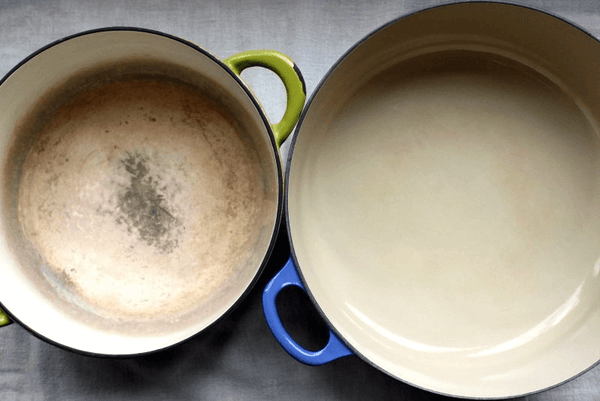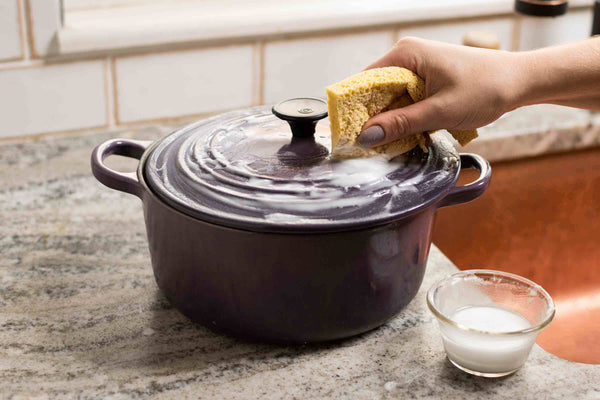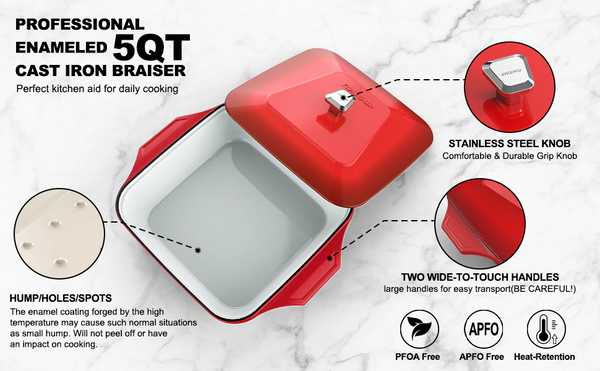TABLE OF CONTENTS
Owning a Dutch oven is one of the last kitchen accessories that are considered an all-in-one solution for cooking and baking. Yet, so many people might be cleaning their Dutch ovens in a wrong way, which will lower their performance and leave it wide open to future damage. This guide will give you excellent tips and proper steps to clean Dutch ovens the right way.

Do You Clean A Dutch Oven? –Tips To Follow
It’s a fair question to ask and obviously, it's essential to clean Dutch ovens after each use. If you haven't owned this type of cast iron cooking vessel before, you’ll know that they need to be seasoned if they don’t come with an enameled cooking surface. Either way, both surfaces are enameled or not; need to be cleaned after each use. This is achieved by taking some very simple steps that are used for both types of Dutch ovens.

-
Tackle the outside first
No matter what type of cooking dish you’ve prepared, most Dutch ovens are a go-to favorite for stews and braised meat dishes. This often includes a fair amount of simmering that also includes dome initial boiling. There might be an occasional rolling boil foam-over that results when you first hit that peak boiling point. Other times, you might simply have simple spills or drips from placing a wooden spoon on the rim that dribbles juices down the outside edges of your pot.
To start the first part of cleaning, you'll need to rinse off your pot with hot water in your sink. Start with the outside since that's what you want to have a good grip on for cleaning the inside. Use a standard kitchen sponge that has a dual scrubber on the opposite side. A generous amount of dish-washing liquid and moderate scrubbing is all that's needed to remove drips or spills on the outside.
Clean the sides and the bottom of the pot until you cannot see any more residual drips and particles stuck to the outside. Rinse these surfaces off and double-check the pot handles too. These can have hidden food drips hiding underneath them that will be harder to clean if you missed them the first time around. By this point, you'll be ready to start cleaning the interior of your cast iron pot.

-
Be gentle with the interior
If you have some real caked-on residue inside your Dutch oven, you'll want to start with a generous hot water soak. This works best when you add a bit of soapy water added to loosen those dried-up surfaces easier. Wait for about 10 minutes before you start cleaning the inside of the pot, so set it aside and clean something else until it’s ready. You should use a regular kitchen sponge with a nylon scrubber on one side for cleaning non-enamel surfaces.
If the build-up is very stubborn, use a tablespoon or two of baking soda on your sponge to help break down that gunk from damaging the cast iron. Enameled pots are very different and should be cleaned the same way that you clean frying pans with Teflon coatings. Once you've cleaned the inside of your pot, give it a good rinse and double-check the outside for any leftovers that haven't been washed off.
A gentle paste created from baking soda and water is soft enough to become a micro-abrasive cleaning powder that helps break down stubborn food residue. Some people have even filled their pot with water with some baking soda and brought it to a boil to remove residue easier. The traditional method is using a standard nylon-based scrubber and dish soap, so be sure to use light pressure when scrubbing an uncoated cast iron vessel.
After it’s cleaned and dried, it will also need to be seasoned on all exposed surfaces, by heating on your stovetop, coated with a layer of vegetable oil, and then baked inside your oven at 200 degrees Fahrenheit for an hour. the more layers that are added, the better that your seasoning will perform as a non-stick surface.

-
Beware of cracks
It might sound impossible that a cast iron pot will develop cracks, yet you would be even more surprised to hear that enameled pots can develop cracks too. Heating cast iron on your stovetop will cause minor heat expansion and contraction for any enamel surface. This is why it will be important to pay close attention to developing cracks that start to appear each time you use your Dutch oven.
The problems start when you see tiny bits of enamel that are missing from your pot. This means that the enamel is starting to fail and will be time to replace this pot or have the enamel removed completely so you can still use it. At that point, it will be necessary to season the surface of the cast iron so it can still have non-stick abilities.
 Enameled Cast Iron Dutch Oven Red Color | 5-Quart | imarku
Enameled Cast Iron Dutch Oven Red Color | 5-Quart | imarku
How Often To Clean A Dutch Oven?
If you’re using Dutch ovens to cook dishes that will leave residue along the inside of the pot, you’ll need to clean it every time it’s used. For some dishes, it’s a matter of cleaning the inside of the pot with a paper towel to wipe away any greasy excess. If the pot needs to be washed with soap and water, you can be sure that it needs to be seasoned afterward to protect the cooking surface.
Using a cast-iron pot for baking bread might only require wiping the inside clean with a few paper towels. Anything with sauces or braises will always need cleaning after these dishes are finished. If you're using this vessel every day for cooking, you can bet it will need cleaning when liquids are involved.
How To Clean An Enameled Cast Iron Dutch Oven?
When it comes to cleaning cast iron enameled surfaces, you need to be delicate and think about gentle scrubbing instead of using force.
You should always soak your pot in hot soapy water (not boiling hot), but hot enough to soften any baked-on foods and sauces. The rest can be removed using a nylon sponge and gentle circular motions over each area that has food or residue left behind. When the interior is clean, simply dry the surface with a towel and store your pot until you need it again.
When the interior is clean, simply dry the surface with a towel and store your pot until you need it again. For more quality options to elevate your cooking, explore our full cookware collection.






















Leave a comment
All comments are moderated before being published.
This site is protected by hCaptcha and the hCaptcha Privacy Policy and Terms of Service apply.